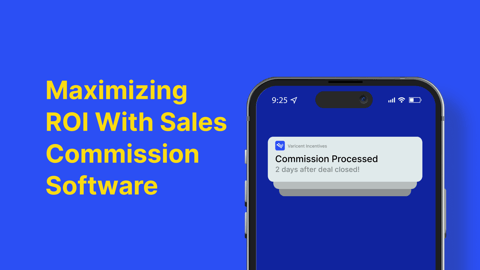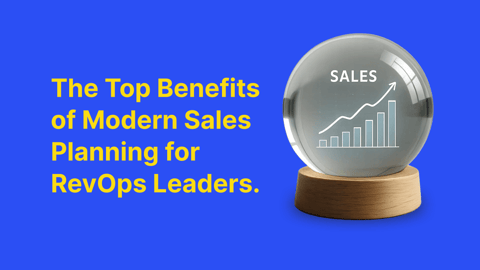- Understanding Sales Forecasting
- Why Is Predictive Sales Forecasting So Important?
- Predictive Tools for Forecasting Sales
- Keys to Predictive Sales Forecasting Success
- A Best Practice Approach to Sales Forecasting
Understanding Sales Forecasting
But the ability to forecast sales is becoming harder. This is due, in part, to the speed of change in many businesses and markets. Now, there’s also a plethora of channels your customers can buy through, whether it’s direct from your business and your sales reps, via your website, or through your partners and affiliates. However, getting a forecast right has never been more critical because of the pace of change in business, which places a significant premium on making the right spending and investment decisions every time. Sales forecasting based purely on intuition and gut feel previous sales data no longer cuts it.
Let's look at sales forecasting in more detail.
Why Is Predictive Sales Forecasting So Important?
In many ways, missing revenue target is one thing, but missing a sales forecast is quite another because this indicates that, in some way, a company is somehow not fully engaged with the market it serves. Secondly, a missed sales forecast can mean significant, but unplanned business decisions have to be made quickly, causing significant business disruption. Accurate forecasting is a must-have for any business, not just a need-to-have.
So, let's explore the detail of why the ability to deliver an accurate sales forecast matters.
1. Improve the Effectiveness of Managing the Business
For example, it’s impossible to forecast every transaction in high-volume, low-value sectors, like Fast Moving Consumer Goods (FMCG), where literally millions of packets of chips or milk cartons are sold monthly. But the sales volumes are so large that even a 1% miss in a sales forecast can significantly impact a company's cash flow and balance sheet. This can impact its share price and its ability to borrow cheaply.
Equally, B2B companies may be selling a smaller number of high-ticket items in complex sales cycles, with decision-makers spread across the business. Here, an accurate sales forecast demonstrates a company's ability to engage effectively with the market and manage the sales and marketing process well. Here, missing a sales forecast not only means missed sales targets. It can also raise red flags with investors that all isn’t well in the C-suite, especially if it means that guidance to investors and shareholders must be revised.
2. Review the Impact of Your Marketing Campaigns
3. Review your Customer Lifetime Value
An accurate sales forecasting framework, leveraging a wide array of data sources, can help companies better understand their customers and market trends and dynamics. It helps them better understand the compelling events and drivers they can influence to drive more sales, enhance customer loyalty, and ultimately increase the revenue stream they can attract over a customer's lifetime. These analytics helps senior management understand and define the business case for future investments based on more than just conjecture and hoping that past sales data mirrors future results.
4. Lower Sales Pipeline and Forecast Risks
Given the value that management, investors, and shareholders place on sales forecasting, especially over a period further out than the next quarter, there’s value in being able to sanity-check sales forecasts provided by a company sales team. Having visibility of the trends, dynamics, and triggers that influence sales volumes can help to provide a check against overly optimistic or pessimistic sales results. It can help provide confidence that the forecasts are accurate and can help you pinpoint the areas to look at closely to fix problems where results are likely to fall short.
Predictive Tools for Forecasting Sales
Clearly, there’s significant value in predicting future revenues accurately. There are several approaches to generating sales forecasts.
The tried and tested model is for sales reps to “commit” to revenues they’ll deliver every week, month, or quarter. This often involves committing deals that they anticipate will close, together with “upside” deals that may close if circumstances allow. This is an exercise in applying experience and judgment by sales reps and sales managers. While not perfect – there’s always a margin for error – it’s what most sales organizations have grown accustomed to. it’s the best for many organizations. It works the best quarter by quarter, and its prime weakness for the Board lies in its unsuitability or reliability more than 2–3 months out.
An alternative is to carry out classic market research and speak with the potential consumers who may buy a product and understand how likely they are to do so. This could be a focus group-based piece of market research or a limited product release for a designated area for a time-limited period. You can then dive deep into the feedback and use the analytics to either refine product and strategy or if you're satisfied with the results, press "go" on the sales pipeline process for the product. This is ideal for a new product or a new company but is time, capital, and labor-intensive.
Get an overview of sales forecasting models and how their methodologies work in the following blog post, Creating Sales Forecasting Models: Everything You Need to Know.
Technology-enabled Tools
In recent years, a new sales forecasting method has emerged, leveraging the capabilities offered by cloud computing, big data, and AI.
Sales performance management applications help companies make the best use of the vast data sets they have access to that can help make informed sales forecasting decisions. By setting up a range of criteria for a specific product, line of products, territory, and sales team target over a week, month, quarter, or year, for example, you can have the confidence you need to deliver an accurate forecast. What's really innovative is how you can now hold up a lens to your prospective buyer's market as well. By including fields on demographics, historical purchasing patterns, and shifts in the local economy, you can better determine what your prospect may be in the market.
Keys to Predictive Sales Forecasting Success
Clearly, there’s significant value in assuring the accuracy of a business's sales forecast. Let's look at what you need to deliver it.
1. Data-driven Information
The first component you need is data and plenty of it. The good news is that sales and marketing teams have never had better access to business data from their own systems and from external sources. The challenge is to make sense of it all without employing your own data scientist.
This data will be found in your CRM systems, your e-commerce systems, your finance systems, your website, in your traffic analytics, even your HR system, as well as data covering wider economic metrics.
2. Communication and Collaboration
Sales and marketing are collaborative processes, with insights, ideas, and feedback constantly provided until everyone comes to a consensus that they can all subscribe to.
Having a consolidated view of this valuable pipeline analytics data can help accelerate this process so that everyone involved in the end-to-end sales and marketing process can look at all the issues from their own unique and valuable perspectives.
The complexity of reviewing and understanding all this data means that it needs to be presented in ways that are intuitive and easy to understand, allowing users to manipulate the data themselves, so they can create their own insights based on their own experience. The ideal is that the comprehensive data set, combined with an easy-to-use interface, means that different users can interrogate the same data to get the results they need for their roles and responsibilities.
3. Ease of Integration
The value of this approach lies in its ability to capture and consolidate large volumes of data from a range of diverse data sources and applications from within the business and elsewhere.
These sources will change and adapt as new sources of data or applications emerge. There’s a significant premium on integrating a sales forecasting platform into other data sources, at the click of a mouse, without the need for coding or the involvement of the IT department. Being able to implement a solution leveraging SaaS-based capabilities allows sales and marketing teams to proceed at their own pace without needing the IT department's support or budget.
4. Real-time Analytics
Business is constantly in a state of flux, with changes constantly feeding through to customers and prospects, which changes their needs, criteria, and decision-making. The changes you make to your offer and the campaigns you run also change the dynamics of your business. The picture will change daily and potentially even hourly in some sectors.
So, how do you stay ahead of these changes while staying on top of the day job?
The smart move is to use AI-based capabilities to monitor the data proactively and provide new insights and themes that could point to new opportunities that can be capitalized on swiftly.
These capabilities allow you to become your own data scientist without employing one or training someone in the business.
5. Ease of Reporting
The last thing that hard-working sales and marketing teams need is an extra report to write every week. Automated reporting capabilities are a key requirement, allowing the forecast results to be passed on to a range of business analytics dashboards from within the tool itself or to another platform.
A Best Practice Approach to Sales Forecasting
While we have explored the fundamentals of sales forecasting, what does a solution look like? What types of functionalities does it feature?
The foundation of the ideal sales forecasting solution centers on leveraging powerful revenue intelligence capabilities. These capabilities enable Sales Directors and Marketing Directors to understand the issues and dynamics of the markets they focus on by collecting millions of data points. These can be related to population and consumer demographics, economic metrics, or metrics related to target companies and the relevant economic indicators that shape their business and their results.
The Tools of the Trade
Easy-to-use data analytics tools can help to refine these data points so that useful insights can be gained by sales and marketing teams. AI capabilities can help enhance staff skills by proactively monitoring data sets for new insights and themes that can provide inspiration and options for new campaigns, product development, and validation for future sales forecasts, often well beyond the current quarter.
Capturing and consolidating these data points requires easy-to-use data integration toolsets so that importing data from a range of systems is quick and easy and can be delivered at the click of a mouse. There’s a premium on utilizing a platform-agnostic environment, as data sets, formats, and business needs constantly change and evolve. Data management flexibility is vital.
The smart move in achieving sales forecasts every quarter and every year is to have the ideal quota model for sales reps, supported by the optimal sales territory model for a sales team. This approach offers the best option for engaging most effectively with the market. It helps ensure that opportunities are fully identified, properly qualified, and closed, providing accurate and timely input into a company's sales forecasting system.
Another smart move is to include accurate forecasting as a sales management metric, which features in an incentive compensation management system. If you reward salespeople for accurate forecasting, as well as quota achievement, the likelihood is that the quality of your overall sales forecasts will improve as well. To learn more, download our eBook on Uncovering New Insights to Illustrate True Sales Yield.
And take control of your sales forecasting future today by talking to your local Varicent specialist and discovering software that will boost your sales team's performance. Ready to get started? Book your demo now!




